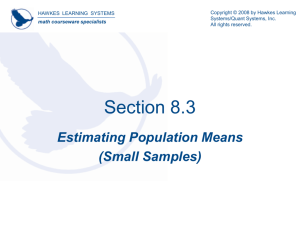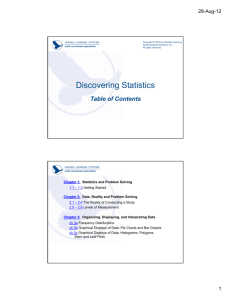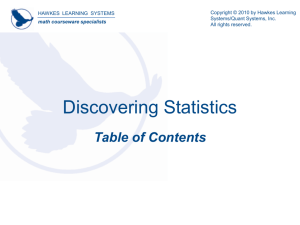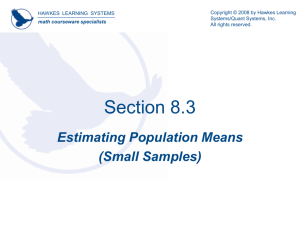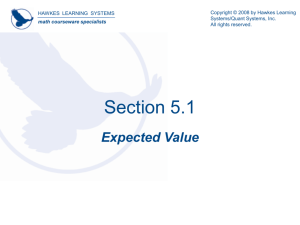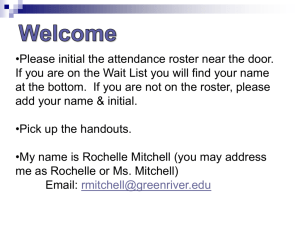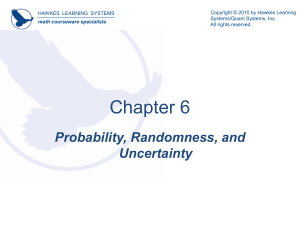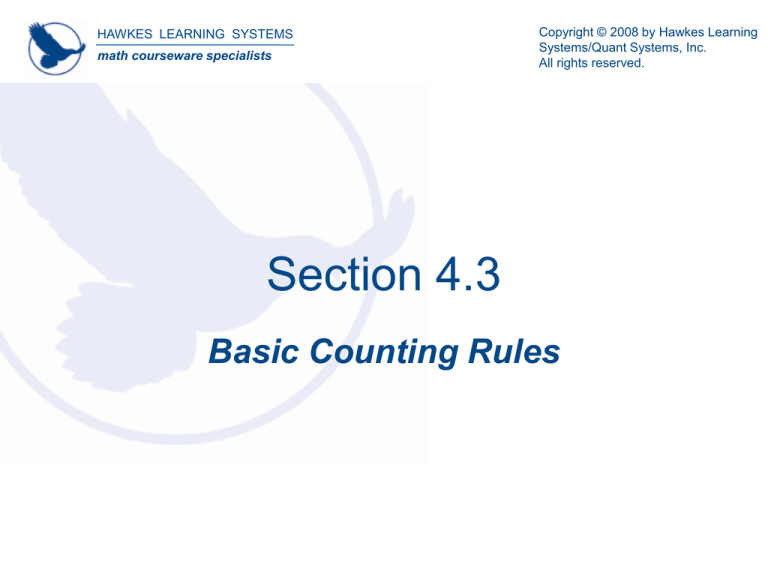
HAWKES LEARNING SYSTEMS
math courseware specialists
Copyright © 2008 by Hawkes Learning
Systems/Quant Systems, Inc.
All rights reserved.
Section 4.3
Basic Counting Rules
HAWKES LEARNING SYSTEMS
Probability, Randomness, and Uncertainty
math courseware specialists
4.3 Basic Counting Rules
Fundamental Counting Principle:
• For a sequence of n experiments where the
first experiment has k1 outcomes, the second
experiment has k2 outcomes, the third
experiment has k3 outcomes, and so forth.
The total number of possible outcomes for the
sequence of experiments is k1 ∙ k2 ∙ k3… kn.
HAWKES LEARNING SYSTEMS
Probability, Randomness, and Uncertainty
math courseware specialists
4.3 Basic Counting Rules
Calculate the total number of outcomes:
Suppose you are ordering a banana split with 4 scoops
of ice cream. If there are 25 flavors to choose from,
and you want each scoop to be a different flavor, then
how many different ways can this banana split be
made?
Solution:
There are 4 slots to fill, one for each different scoop of
ice cream.
For the first scoop you, will have 25 flavors to choose
from.
For the second scoop, you will have 24 flavors to
choose from, and so forth.
Therefore there are (25)(24)(23)(22) = 303,600 different
ways to make your banana split.
HAWKES LEARNING SYSTEMS
Probability, Randomness, and Uncertainty
math courseware specialists
4.3 Basic Counting Rules
Factorial:
• The product of all positive integers less than
or equal to n.
• Symbolically,
n! = n(n – 1)(n – 2)…(2)(1)
• 0! = 1
HAWKES LEARNING SYSTEMS
Probability, Randomness, and Uncertainty
math courseware specialists
4.3 Basic Counting Rules
Calculate the following factorial expressions:
a. 7!
7! = (7)(6)(5)(4)(3)(2)(1) = 5040
b.
c.
d.
HAWKES LEARNING SYSTEMS
Probability, Randomness, and Uncertainty
math courseware specialists
4.3 Basic Counting Rules
Permutations and Combinations:
• When you need to count the number of ways
objects can be chosen out of a group, in
which the order the objects are chosen is
important, it is called a permutation.
“n things permuted r at a time”
• When you need to count the number of ways
objects can be chosen out of a group, in
which the order the objects are chosen is not
important, it is called a combination.
“n choose r ”
HAWKES LEARNING SYSTEMS
Probability, Randomness, and Uncertainty
math courseware specialists
4.3 Basic Counting Rules
Answer the following:
A class of 23 fifth graders is holding elections for
class president, vice-president, and secretary.
How many different ways can the officers be
elected?
Solution:
In this problem, order is important.
We have n = 23 and r = 3.
HAWKES LEARNING SYSTEMS
Probability, Randomness, and Uncertainty
math courseware specialists
4.3 Basic Counting Rules
Answer the following:
Consider that a cafeteria is serving the following
vegetables for lunch one day: carrots, broccoli,
spinach, baked beans, corn, and green beans.
Suppose you will to order a vegetable plate with 4
different vegetables. How many ways can this plate be
prepared?
Solution:
In this problem, order is not important.
We have n = 6 and r = 4.
HAWKES LEARNING SYSTEMS
Probability, Randomness, and Uncertainty
math courseware specialists
4.3 Basic Counting Rules
Special Permutations:
• The number of permutations of n objects in
which k1 are all alike, k2 are all alike, etc., is
given by
HAWKES LEARNING SYSTEMS
Probability, Randomness, and Uncertainty
math courseware specialists
4.3 Basic Counting Rules
Answer the following:
How many different ways can you arrange the
letters in the word Tennessee?
Solution:
We cannot make a distinction between each “e”,
“n”, or “s”.
We have T = 1, E = 4, N = 2, S = 2.

